
Edward Winter

Nomination for the name most commonly misspelled nowadays: Octavio Trompowsky (1897-1984), the Brazilian player best (or only) remembered for the opening 1 d4 Nf6 2 Bg5. Quite apart from ‘Trompowski’ and ‘Trompovsky’, the ECO has helped start a trend towards ‘Trompovski’. It cannot be said when the moves 1 d4 Nf6 2 Bg5 were first played, but pre-Trompowsky cases exist, an example being the game between Stepan Levitzky and Amos Burn, Breslau, 27 July 1912. Play continued 2 ... g6 3 Bxf6 exf6 4 c4 Bg7 5 Nc3 O-O 6 e3 d6 7 Bd3 (the tournament book says that 7 g3 and 8 Bg2 come into consideration) 7…f5 8 Nge2 Nd7 9 Qc2 Nf6 10 O-O c6 11 b4 Re8 12 Rab1 Qe7 13 b5 Ne4 14 bxc6 bxc6 15 Bxe4 fxe4 16 Qa4, and the game was eventually drawn (at move 57). Information about other early cases of 1 d4 Nf6 2 Bg5 would be welcome.
(Kingpin, 1992)
The question of the origins of the Trompowsky Opening was taken up on pages 11-12 of the 7/1992 New in Chess, without any earlier specimens being offered. One can be added now, although it arises by transposition:
Stepan Mikhailovich Levitzky – Stefan Konstantinovich
Isbinski
Russian National Tournament, St Petersburg, October 1911
Trompowsky Opening
1 d4 d5 2 Bg5 Nf6 3 Bxf6 gxf6 4 c4 c5 5 cxd5 Qxd5 6 e3 cxd4 7 Nc3 Qa5 8 exd4 Bg7 9 Bd3 Nc6 10 Ne2 Bg4 11 f3 Bd7 12 O-O Nxd4 13 Nxd4 Qb6 14 Bc4 f5 15 Kh1 Bxd4 16 Nd5 Qc5 17 Rc1 Rc8 18 b4 Qxc4 19 Rxc4 Rxc4 20 Qe2 Black resigns.
Source: Deutsche Schachzeitung, January 1912, page 10.
Levitzky won the tournament. Stefan Isbinski (or Izbinsky), who finished third, was to die about six months later, aged 27.
(Kingpin, 1995)
An addition to the two above items when they were given on page 147 of Kings, Commoners and Knaves:
The following game, difficult to attribute precisely (it has, for instance, been given as Stackpole v Kirkham, 1881 and B. Kirkham v G. Mackenzie, 1881) is given in various databases:
1 d4 Nf6 2 Bg5 Ne4 3 Bh4 c5 4 f3 Qa5+ 5 c3 Nd6 6 d5 g6 7 e4 b5 8 Bd3 Bg7 9 Ne2 b4 10 Qd2 c4 11 Bc2 b3 12 Bd1 Nb5 13 Bf2 Qxa2 14 Rxa2 bxa2 15 Na3 Nxa3 16 Qc1 Nb1 17 Bc2 a1(Q) 18 Bxb1 d6 19 O-O Nd7 20 White resigns.
Annotating his game against Endzelins in the Munich, 1936 Olympiad, which began 1 d4 Nf6 2 Bg5, Trompowsky wrote of the bishop move:
‘My variation, which I have been playing for more than 15 years.’
Source: Deutsche Schachblätter, 15 October 1936, page 368.

Can readers supply corroborative game-scores?
(2375)
Christian Sánchez (Rosario, Argentina) writes:
‘According to page 181 of El Ajedrez Argentino, June 1947, Octavio Trompowsky gave some games with his opening in his book Partidas de Xadrez.’
(4306)
Eduardo Bauzá Mercére (New York, NY, USA) reports on the content of Partidas de Xadrez, which was published in 1941. In the first note to the above-mentioned game against Endzelins, given on pages 71-72, Trompowsky wrote of 2 Bg5:
‘Um lance especialmente analizado pelo autor destas linhas, com o intúito de fugir aos livros e poder enfrentar os mestres com armas mais ou menos iguais.’ [‘A move especially analysed by the author of these lines, with the intention of avoiding the books and being able to fight against masters on more or less equal terms.’]
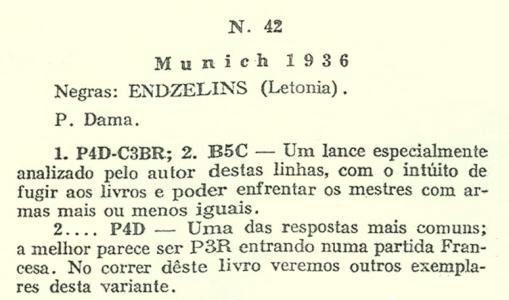
That is the book’s first specimen of 1 d4 Nf6 2 Bg5, the later cases being:
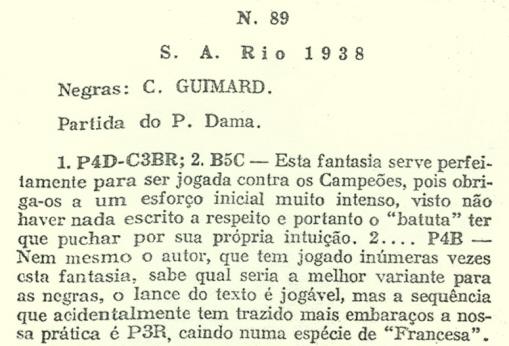
All the above-listed games were annotated by Trompowsky. His victories against Endzelins and Kiproff were played on 22 and 29 August 1936 respectively, and the former game thus remains the earliest specific instance known to us of 1 d4 Nf6 2 Bg5 being played by Trompowsky.
Mr Bauzá Mercére notes, though, that pages 43-44 feature a game played by telegraph in 1925 between Montalbán (White) and Trompowsky. It began 1 d4 d5 2 Bg5, after which Trompowsky wrote:
‘Uma fantasia interessante que Tartakower batizou de “Vôo no Azul” e que tem pelo menos o mérito de sair dos livros. Tarrasch disse algures que êste Bispo procurava pregar a sombra do Cavalo!’ [‘An interesting fantasy, which Tartakower christened a “Flight into the Blue” and which at least has the merit of leaving the books. Tarrasch said somewhere that this bishop was trying to pin the knight’s shadow!’]
Our correspondent remarks too how often José Montalbán played 2 Bg5 at Carrasco, 1921-22 and Mar del Plata, 1928. As regards the former event, for instance, the Lachaga tournament book published in 1980 shows that Montalbán’s openings with White were as follows:
(5261)
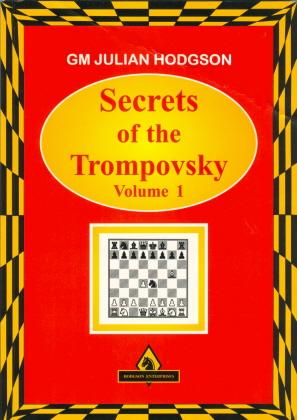
In a recent article for ChessBase we discussed faulty book covers and reproduced the above specimen, our caption being ‘Trompovsky instead of Trompowsky’.
Now Anthony Wood (London) mentions that the spelling ‘Trompovsky’ was deliberate on the part of Julian Hodgson, who wrote on page 8:
‘... the opening was actually named after Octavio Siqueiro Trompowsky, one time Brazilian Champion, who popularised it in the 1930s and 1940s. For simplicity’s sake I have renamed the opening itself phonetically Trompovsky ...’
(6045)
From various Portuguese and Brazilian websites we note that Trompowsky’s forename takes an acute accent on the a: Octávio.
(5297)
From El Ajedrez Americano, October 1933, page 263:
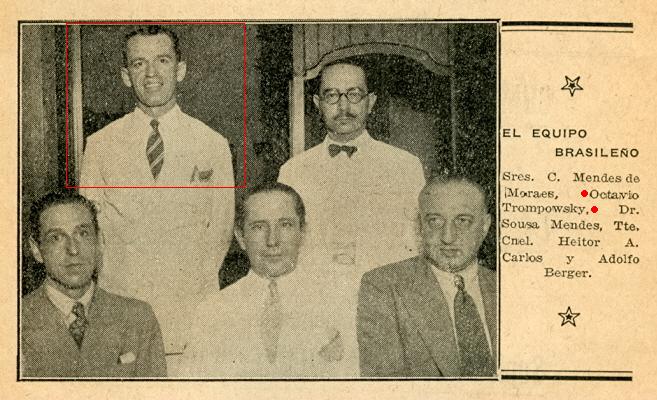
Below is a comment on 1 d4 Nf6 Bg5 from page 43 of Power Mates by Bruce Pandolfini (New York, 1996):
‘This is called Trompowsky’s Attack internationally, but Americans know it as Bill Ruth’s Opening. The Camden, New Jersey, Master was playing his opening back in the early 1920s, long before Trompowsky arrived on the scene. Ruth liked its offbeat qualities and the chance to weave some tricky traps. These same attractions hold good today.’
William Allen Ruth (1886-1975) was also mentioned in this context on page 57 of America’s Chess Heritage by Walter Korn (New York, 1978):
‘He made a name for himself in early-American opening theory by popularizing the Ruth Opening 1 P-Q4 N-KB3 2 B-N5, which in later epochs of unlimited means of publicity was “adopted” as the Trompovsky or the Veressov Opening.’
On several occasions Robert Byrne gave Ruth credit for the opening. From his column on page v 15 of the New York Times, 17 January 1993:
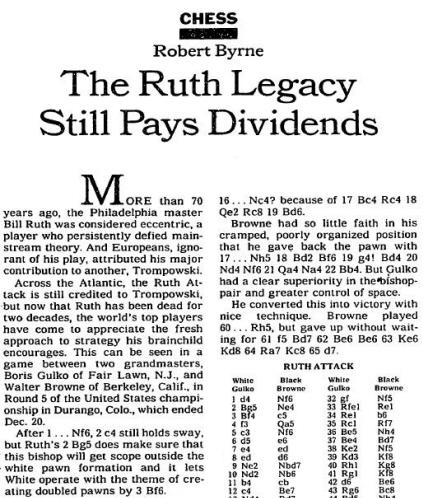
On page C5 of the 17 January 1995 edition Byrne wrote:
‘Seventy years ago the Philadelphia master Bill Ruth promulgated the move 2 Bg5, which makes sure that the white queen bishop will obtain scope outside the pawn formation. It also creates the option of Bf6, forcing doubled pawns. The most active counter-measure is 2...Ne4.’
What can be traced about Ruth’s use or advocacy of 1 d4 Nf6 2 Bg5 in the 1920s? (Games from the 1930s can be found; see, for instance, Ruth v Elo, Milwaukee, 1935, on pages 20-21 of the tournament book.)
As shown in the cutting above, Byrne wrote ‘Ruth Attack’. In his column on pages 26-27 of the May 1996 Chess Life he put ‘Ruth Opening’:

The Miles v Conquest game was played in the second round of the Hastings, 1995-96 tournament, on 29 December 1995; the results were reported in the following day’s edition of the Guardian, page 19.
On page 29 of the November 1995 Chess Life Edmar Mednis referred to 1 d4 Nf6 2 Bg5 as the ‘Trompowsky-Ruth Attack’, whereas on page 290 of Chess Thinking (New York, 1995) Bruce Pandolfini called it the ‘Ruth-Trompowsky Attack’. Editions of Modern Chess Openings have presented a range of contradictory information, and page 441 of the 13th edition (London, 1990), edited by Walter Korn and revised by Nick de Firmian, introduced another player as a ‘co-author’ of the opening:
‘The Trompowski Attack was co-authored by Opočenský (along with Trompowski) in the 1930s, but long before them it was consistently propagated by the American W.A. Ruth.’
The passage thus also introduced another verb, ‘propagate’, to join ‘popularize’ and ‘promulgate’ as descriptions of Ruth’s activity with 1 d4 Nf6 2 Bg5, but where are the hard facts?
Our earlier material on Trompowsky’s use of the opening has been brought together with the present item in ‘The Trompowsky Opening’, so that, within a single article, it is possible to peruse the entire nomenclatural shambles.
(8732)
C.N. 5261 above mentioned that pages 43-44 of Octávio Trompowsky’s 1941 book Partidas de Xadrez have a game which he played by telegraph in 1925 against José Montalbán (White). After 1 d4 d5 2 Bg5 Trompowsky wrote:
‘Uma fantasia interessante que Tartakower batizou de “Vôo no Azul” e que tem pelo menos o mérito de sair dos livros. Tarrasch disse algures que êste Bispo procurava pregar a sombra do Cavalo!’ [‘An interesting fantasy, which Tartakower christened a “Flight into the Blue” and which at least has the merit of leaving the books. Tarrasch said somewhere that this bishop was trying to pin the knight’s shadow!’]
Do readers have information about such a remark by Tarrasch, or by others? We can offer only a vague citation for the phrase on pages 234-236 of The Year-Book of Chess 1915 and 1916 by W.H. Watts and A.W. Foster (London, 1917). The game between R.H.V. Scott and T. Germann was played in 1915, in the 1915-16 City of London Chess Club Championship, and the notes were by Amos Burn in The Field.
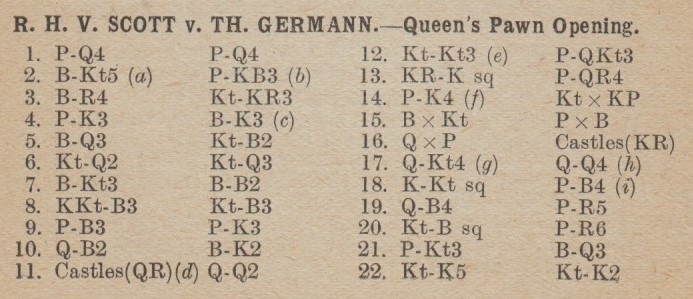
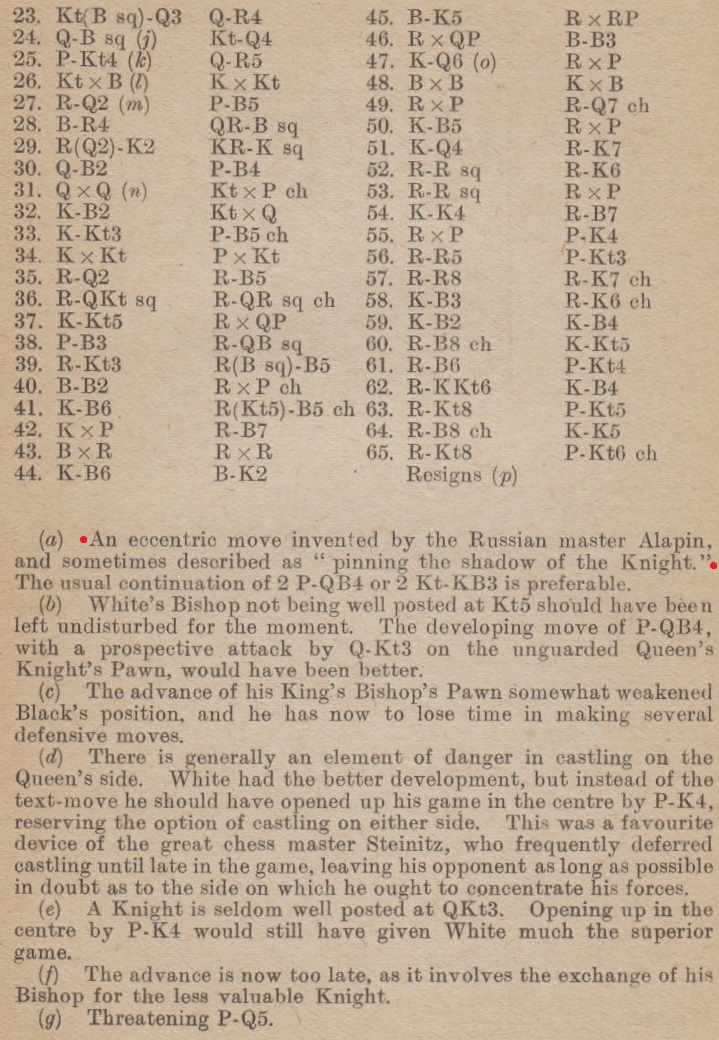
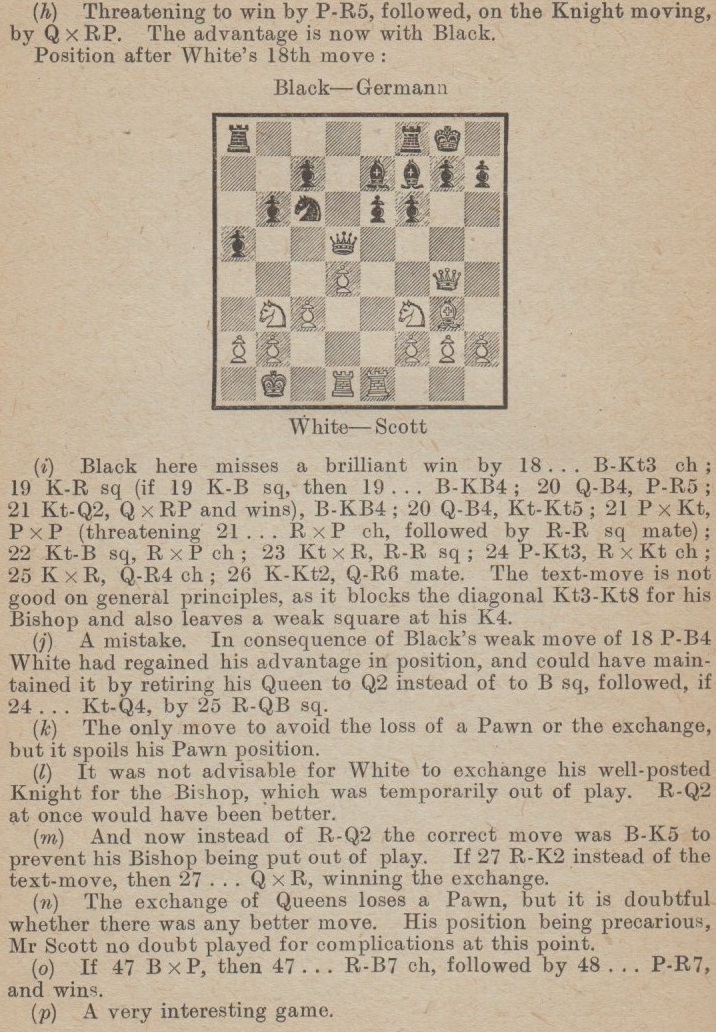
1 d4 d5 2 Bg5 f6 3 Bh4 Nh6 4 e3 Be6 5 Bd3 Nf7 6 Nd2 Nd6 7 Bg3 Bf7 8 Ngf3 Nc6 9 c3 e6 10 Qc2 Be7 11 O-O-O Qd7 12 Nb3 b6 13 Rhe1 a5 14 e4 Nxe4 15 Bxe4 dxe4 16 Qxe4 O-O 17 Qg4 Qd5 18 Kb1 f5 19 Qf4 a4 20 Nc1 a3 21 b3 Bd6 22 Ne5 Ne7 23 Ncd3 Qa5 24 Qc1 Nd5 25 b4 Qa4 26 Nxf7 Kxf7 27 Rd2 f4 28 Bh4 Rac8 29 Rde2 Rfe8 30 Qc2 c5 31 Qxa4 Nxc3+ 32 Kc2 Nxa4 33 Kb3 c4+ 34 Kxa4 cxd3 35 Rd2 Rc4 36 Rb1 Ra8+ 37 Kb5 Rxd4 38 f3 Rc8 39 Rb3 Rcc4 40 Bf2 Rxb4+ 41 Kc6 Rbc4+ 42 Kxb6 Rc2 43 Bxd4 Rxd2 44 Kc6 Be7 45 Be5 Rxa2 46 Rxd3 Bf6 47 Kd6 Rxg2 48 Bxf6 Kxf6 49 Rxa3 Rd2+ 50 Kc5 Rxh2 51 Kd4 Re2 52 Ra1 Re3 53 Rh1 Rxf3 54 Ke4 Rf2 55 Rxh7 e5 56 Rh5 g6 57 Rh8 Re2+ 58 Kf3 Re3+ 59 Kf2 Kf5 60 Rf8+ Kg4 61 Rf6 g5 62 Rg6 Kf5 63 Rg8 g4 64 Rf8+ Ke4 65 Rg8 g3+ 66 White resigns.
The Trompowsky Opening article notes that 2 Bg5 was frequently played by José Montalbán, and we add now that he even used it against Alekhine. The score below is taken from pages 59-60 of Ajedrez uruguayo (1880-1980) by Héctor Silva Nazzari (Montevideo, 2013):
José Montalbán – Alexander Alekhine
Montevideo, 27 October 1926
Trompowsky Opening
1 d4 Nf6 2 Bg5 c5 3 d5 Qb6 4 Bxf6 gxf6 5 Qc1
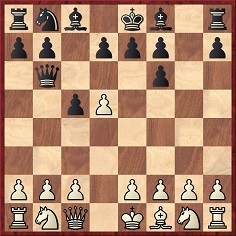
5...Bh6 6 e3 d6 7 c4 Bf5 8 Nc3 Nd7 9 f4 e5 10 g3 exf4 11 gxf4 O-O-O 12 Qd2 Qb4 13 Nb5 Qxd2+ 14 Kxd2 Nb6 15 Bd3 Bxd3 16 Kxd3 Rhg8 17 Ne2 a6 18 Nbc3 Rg6 19 Rhg1 Kd7 20 Ng3 Rdg8 21 Nce2 Nc8 22 Nf5 Bf8 23 Rg3 Ne7 24 Ke4 Nxf5 25 Kxf5 Ke7 26 Rag1 Rh8 27 Rh3 Bh6 28 Ng3 b5 29 Rc1 Kd7 30 b4 cxb4 31 cxb5 axb5 32 Ne4 Ra8 33 Rc6 Rxa2 34 Nxf6+ Kd8 35 Rxd6+ Kc8 36 Ne4 Bf8 37 Rxg6 fxg6+ 38 Ke6
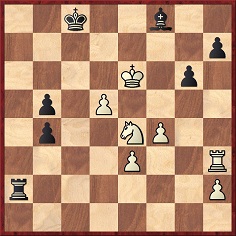
38...b3 39 Nc3 b2 40 d6 b4 41 Nb1 Ra1 42 e4 Bxd6 43 Rb3 Rxb1 44 e5 Kd8 45 h4 Ke8 46 h5 gxh5 47 White resigns.
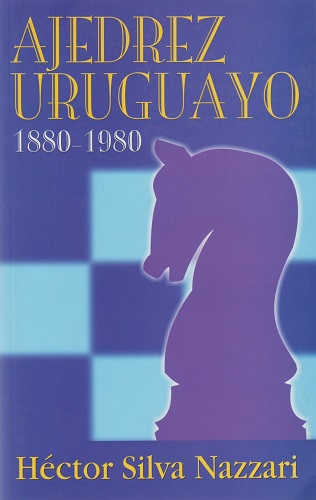
Page 57 provides information on that first visit of Alekhine’s to Uruguay: +84 –7 =9 in four simultaneous displays, 11½ points out of 12 in six two-board sessions with clocks, a lecture and a blindfold display (score unknown). The circumstances of the game against Montalbán are not specified.
(8972)
Photographs of Trompowsky are very rare. A small one of him in play (left) against Guimard (Montevideo, 1938) was shown in C.N. 9916, from page 113 of El Ajedrez Americano, April 1938:

Eduardo Bauzá Mercére provides this photograph from Xadrez Brasileiro, May 1939, page 63:
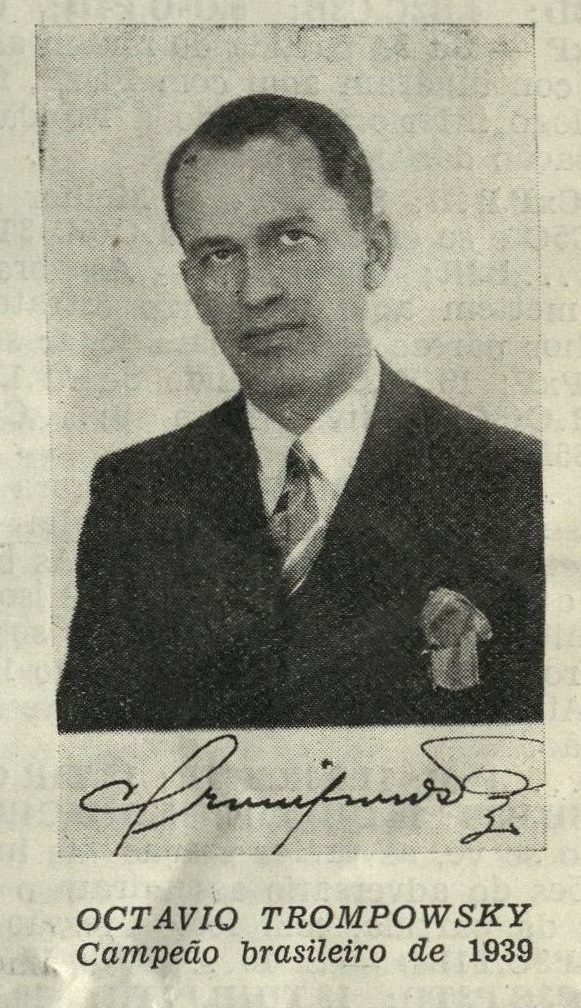
(10768)
Eduardo Bauzá Mercére sends this telephone game played by Ruth (White) against I.S. Turover from page 6 of the Philadelphia Inquirer, 17 December 1922:
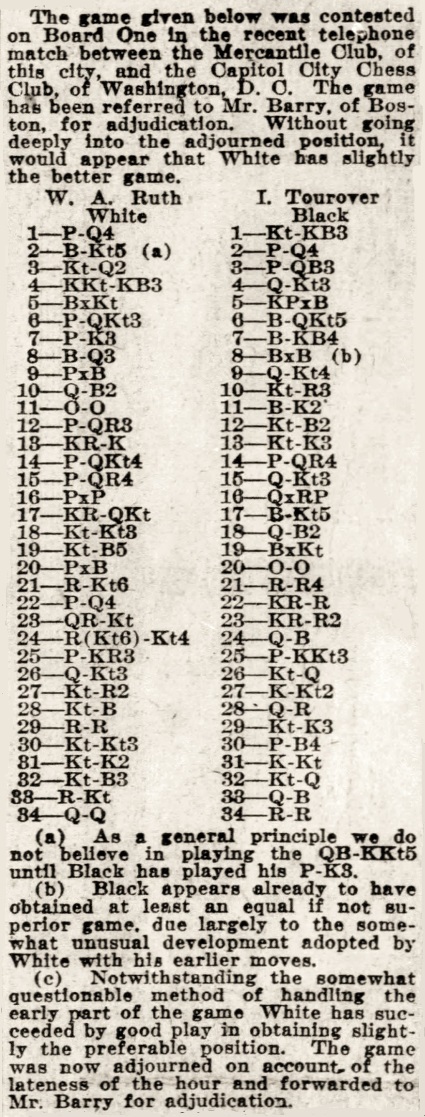
1 d4 Nf6 2 Bg5 d5 3 Nd2 c6 4 Ngf3 Qb6 5 Bxf6 exf6 6 b3 Bb4 7 e3 Bf5 8 Bd3 Bxd3 9 cxd3 Qb5 10 Qc2 Na6 11 O-O Be7 12 a3 Nc7 13 Rfe1 Ne6 14 b4 a5 15 a4 Qb6 16 bxa5 Qxa5 17 Reb1 Bb4 18 Nb3 Qc7 19 Nc5 Bxc5 20 dxc5 O-O 21 Rb6 Ra5 22 d4 Rfa8 23 Rab1 R8a7 24 R6b4 Qc8 25 h3 g6 26 Qb3 Nd8 27 Nh2 Kg7 28 Nf1 Qa8
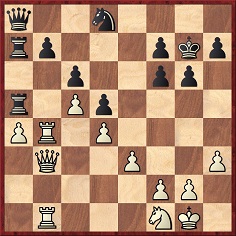
29 Ra1 Ne6 30 Ng3 f5 31 Ne2 Kg8 32 Nc3 Nd8 33 Rb1 Qc8 34 Qd1 Ra8. Submitted for adjudication.
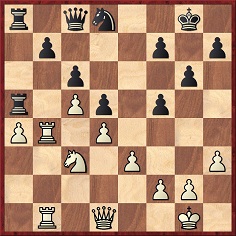
Page 6 of the 14 January 1923 edition reported that J.F. Barry had adjudicated the game as a draw.
(10862)
Addition on 23 December 2023:
Alan Smith (Stockport, England) submits a game between Bogoljubow and Wainstein published on page 2 of Het Volk, 30 March 1918: 1 d4 Nf6 2 Bg5 e6 3 e4 h6 4 Bxf6 Qxf6 5 Nc3 Bb4 6 Nf3 d5 7 Bd3 c5 8 O-O cxd4 9 Nb5 Na6 10 a3 Bc5 11 b4 dxe4 12 Bxe4 Be7 13 Qe2 O-O 14 Rad1 Rd8 15 Ne5 Bd6 16 f4 Nc7 17 Rxd4 Nxb5 18 Qxb5 Bc7 19 Rfd1 Qe7 20 Rxd8+ Bxd8 21 c4 a5 22 c5 axb4 23 c6 Ra7 24 axb4 f6 25 Ng6 Qc7 26 cxb7 Qb6+ 27 Kh1 Resigns.
Our correspondent comments:
‘No event was given, but Triberg, 1916 or 1917 seems likeliest.’
Mr Smith also sends the following occurrences of 1 d4 d5 2 Bg5:
Fred Brown v Jones Bateman, Bath, 1900: 2...Bf5 3 Nd2 Nf6 4 Ngf3 h6 5 Bh4 Nc6 6 c3 Qd7 7 e3 g5, and White won at move 38 (Nottinghamshire Guardian, 13 October 1900, page 2;
Fred Brown v Henry Atkins, Bath, 1900: 2...c5 3 dxc5 f6 4 Be3 e5 5 c3 a5 6 g3 Nc6 7Bg2 Nge7, and Black won at move 28 (Morning Post, 17 September 1900, page 3.
To the Chess Notes main page.
To the Archives for other feature articles.
Copyright: Edward Winter. All rights reserved.